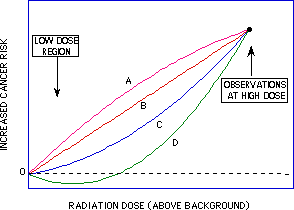The debate over the dangers of radioactive materials to human health has been raging for over a hundred years since the discovery of radioactive elements. It can be easily demonstrated that high levels of radiation cause immediate harm to human tissue. Moderate levels of radiation can have long terms effects on human health. The natural environment contains radiation emitted from uranium and radium in the soil and rocks. We evolved with this natural background radiation and some think that it is not harmful and may even be beneficial to health. The idea of low level radiation strengthening tissue against higher levels of radiation is known as "hormesis." It has been rejected by most of the scientific community.
The NRC has just accepted a petition from three people representing the Scientists for Accurate Radiation Information that the NRC amend its "Standards for Protection Against Radiation." Currently the NRC abides by the Linear No-Threshold (LNT) model which holds that radiation is always harmful and there is no "safe" threshold below which radiation is not damaging. The LNT model states that "biological damage caused by ionizing radiation (essentially the cancer risk) is directly proportional to the amount of radiation exposure to the human body (response linearity)."
The three petitioners are in health related fields. They claim that there is no solid evidence that low doses of radiation are harmful to human health and that compliance with the current limits on exposure are an unnecessary expense for their professions. A Dr. Doss, one of the petitioners, said that he was filing the petition on behalf of Scientists for Accurate Radiation Information, whose mission is to “help prevent unnecessary, radiation-phobia-related deaths, morbidity, and injuries associated with distrust of radio-medical diagnostics/therapies and from nuclear/radiological emergencies through countering phobia-promoting misinformation spread by alarmists via the news and other media including journal publications. "
Australian Dr. Peter Karamoskos, a nuclear radiologist and a public representative on the radiation health committee of the Australian Radiation Protection and Nuclear Safety Agency said in a 2011 article, "“There seems to be a never-ending cabal of paid industry scientific ”consultants” who are more than willing to state the fringe view that low doses of ionizing radiation do not cause cancer and, indeed, that low doses are actually good for you and lessen the incidence of cancer.” He continues with "Ionizing radiation is a known carcinogen. This is based on almost 100 years of cumulative research including 60 years of follow-up of the Japanese atom bomb survivors. The International Agency for Research in Cancer (IARC, linked to the World Health Organization) classifies it as a Class 1 carcinogen, the highest classification indicative of certainty of its carcinogenic effects.”
The HealFukushima.org Alert issued a bulletin on what adoption of the hormesis concept could do: "If adopted, this would permit all current radioactive releases, leaks, and ongoing emissions from nuclear power plants, and decrease evacuation zones, as well as allow Fukushima, Chernobyl, WIPP (New Mexico nuclear waste disposal site), Hanford, Oak Ridge, Nevada and Alaska test sites, Santa Susanna, Farallons nuclear waste dump, depleted uranium, nuclear weapons, and other international emissions, as long as the government deems them to be “low level”, to impact Americans under the fantasy of a hormesis effect.
No protective measures or public safety warnings would be considered necessary. Clean-up measures could be sharply reduced. Protection for medical and screening personnel working around radiation-emitting equipment could be reduced.
In a sense, this would legalize what the government is already doing – failing to protect the public and promoting nuclear radiation….
The NRC standardneeds revised to be more protective. Just like non-ionizing wireless radiation exposure, impact is not necessarily linear. Chronic low dose can be much worse than a one-time high dose."
Critics of the NRCs discussions of hormesis claim that much of the motivation for considering lowing radiation exposure standards would reduce the responsibility and expense of both government and industry to protect people from the repercussions of nuclear accidents.
Alternative assumptions for the extrapolation of the cancer risk vs. radiation dose to low-dose levels, given a known risk at a high dose: supra-linearity (A), linear (B), linear-quadratic (C) and hormesis (D).
